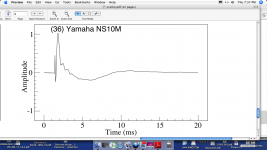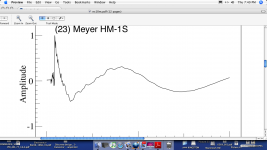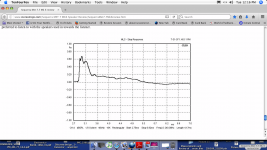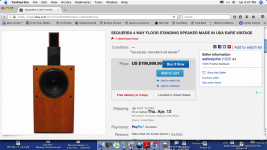If you are using ohms law to say that at a specific voltage and current the load behaves as a resistance of some value and that changes as voltage or current changes, then why are you bothering to calculate the resistance?
Who teaches anything different these days (I don't care what the wiki says)? In high school maybe to give people a basic understanding of electronics. Dan's view is what I learned the voltage and current are measurable against accepted international standards the incremental resistance is what's left. You calculate the integral of the power in the resistance because (save for radiation) that is where the energy is lost as heat or real power delivered.
You can fool old school power meters, even make them run backwards, but that's their problem not the physics.
You might 'quibble' about speaker directivity, but my listening experience tells me that even overall frequency response is not nearly as important as TIME RESPONSE. The MET 7 has a great 'time response'.
The MET 7 has a great 'time response'.
So does the NS-10, and some stereo sealed subs being used along with them here.
NS-10 impulse, waterfall, etc., all right here: http://dt7v1i9vyp3mf.cloudfront.net/assetlibrary/n/ns10m.pdf?jQWj8tYIeZeymRCNXitG9Qfwq9mLf1t0
NS-10 impulse, waterfall, etc., all right here: http://dt7v1i9vyp3mf.cloudfront.net/assetlibrary/n/ns10m.pdf?jQWj8tYIeZeymRCNXitG9Qfwq9mLf1t0
I'd stick with the toilet paper over the tweeters, lots of it. (humor alert) 🙂. BTW I listened to them in Yamaha's own reference listening room (1988), not pleasant to me.
Last edited:
Actually, I do have a small single layer from a double layer paper towel partially diffusing each HF driver. They hang from the top a bit in front of all but the lower 1/4th or so of each driver, and there is a thin vertical slit in the middle running up about half-way exposing a bit more of directly radiated sound. Adjusted to taste, and doesn't sound bad. With the subs, the frequency response is decent but not tweaked perfectly flat. Percussion instruments produce tight impulses and cymbals sound pretty real. Of course, it doesn't hurt that the old Bryston 4B was recently retired and replaced with an AHB2.
EDIT: They are NS-10M to be precise. Sorry if any confusion.
EDIT: They are NS-10M to be precise. Sorry if any confusion.
Last edited:
I used to use a man's (mine) sock to cover the tweeter of the Wilson WATT1 speaker. It worked just fine!
Now for time measurements: Here are three that show that the Yamaha, which is better than many, is not nearly as accurate as the Met 7 or even the Meyer.
Now for time measurements: Here are three that show that the Yamaha, which is better than many, is not nearly as accurate as the Met 7 or even the Meyer.
Attachments
Okay, why don't they use Met-7 to mix records, given that they are so accurate as you describe?
Okay, why don't they use Met-7 to mix records, given that they are so accurate as you describe?
They don't go to 11?
I don't ever mix at over 85dB SPL at the listening position, mostly lower. Too loud causes ear fatigue. Now, firing up the 'bigs' in the soffit when the band comes in to see how good it sounds might go a fair bit louder, maybe 11 if you let somebody else touch the knobs.
You just have to live with them to know their qualities. However you have to go to a full range Sequerra Speaker to get a true monitor.
That's hilarious, really $200,000 for parts I should tell my wife. Her sister threw my pair of the ribbons on top in the trash.
Yes !You might 'quibble' about speaker directivity, but my listening experience tells me that even overall frequency response is not nearly as important as TIME RESPONSE.
And I believe the first designer who had the idea to time align his speakers was Mr Leon,, Founder of Elipson.

More than 50 years ago.
Now, with the active filters, DSP based, we can optimize the group delay without to worry about the enclosures design.
Last edited:
Hi John,
The bottom scale isn't visible for the Meyer. You can't tell much, and the Yamaha seems to have less overhang than the Meyer does. Is the pulse at time zero? If so, the Yamaha is doing very well, not withstanding the fact that I wouldn't want them for speakers to listen to.
Just for comparison, would you have pictures that show each speaker? It would be interesting to see the beast with it's response.
-Chris
The bottom scale isn't visible for the Meyer. You can't tell much, and the Yamaha seems to have less overhang than the Meyer does. Is the pulse at time zero? If so, the Yamaha is doing very well, not withstanding the fact that I wouldn't want them for speakers to listen to.
Just for comparison, would you have pictures that show each speaker? It would be interesting to see the beast with it's response.
-Chris
I used to delay the left channel of CDs for listening in the car. Used some editing software before I burn the CD.
I think my cheap Tannoy MX2-M has a decent time response and that´s what made the speaker attractive to me. The crossover is 1st order electrical.
I think my cheap Tannoy MX2-M has a decent time response and that´s what made the speaker attractive to me. The crossover is 1st order electrical.
Okay, why don't they use Met-7 to mix records, given that they are so accurate as you describe?
great at one parameter is not as good as great at many parameters of importance. I want it ALL. 🙂
JBL M2 Audiolense Digital Crossovers w/Subs | Audio Science Review (ASR) Forum
M2 measured data shown.
THx-RNMarsh
Last edited:
Not married ?I used to delay the left channel of CDs for listening in the car.
- Status
- Not open for further replies.
- Home
- Member Areas
- The Lounge
- John Curl's Blowtorch preamplifier part III







